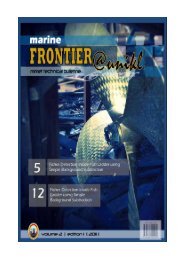click here to download - UniKL MIMET Official Website
click here to download - UniKL MIMET Official Website
click here to download - UniKL MIMET Official Website
Create successful ePaper yourself
Turn your PDF publications into a flip-book with our unique Google optimized e-Paper software.
adversely affecting ship operations, survivability,<br />
or life. Examples are hotel loads such as heating<br />
and galley; ship, avionics, and ground support<br />
equipment shops; aircraft fueling systems; refrig‐<br />
eration systems; and other loads that can be<br />
shut down for a short time until full electric<br />
power capability is res<strong>to</strong>red.<br />
Semi‐vital (Semi‐essential) ‐ Loads important <strong>to</strong><br />
the ship but that can be shut down or switched<br />
<strong>to</strong> the alternate plant in order <strong>to</strong> prevent <strong>to</strong>tal<br />
loss of ship’s electrical power. Examples include<br />
aircraft and cargo eleva<strong>to</strong>rs, assault systems,<br />
some radar, communications, and seawater ser‐<br />
vice pumps.<br />
Vital (Essential) – Non‐sheddable loads that af‐<br />
fects the survivability of ship or life. Power <strong>to</strong><br />
these loads is not intentionally interrupted as<br />
part of a load shedding scheme. Examples of vi‐<br />
tal loads are genera<strong>to</strong>rs, boilers, and their auxil‐<br />
iaries; close‐in weapon systems; electronic coun‐<br />
termeasures; tactical data system equipments<br />
with volatile memories; medical and dental op‐<br />
erating rooms; and primary air search radar.<br />
The vital loads are required <strong>to</strong> be connected <strong>to</strong><br />
two independent power sources in the SPS. If a<br />
load is classified as vital load at any major mis‐<br />
sion of the ship, such as propulsion system, it has<br />
<strong>to</strong> be connected <strong>to</strong> the SPS through Au<strong>to</strong>matic<br />
Bus Transfer (ABT). ABT is a device that can<br />
sense the loss of power from normal power<br />
source. When normal power is absent, ABT can<br />
au<strong>to</strong>matically disconnect the load from the nor‐<br />
mal power and switch the load’s power flow<br />
from an alternate power source. ABTs are de‐<br />
signed <strong>to</strong> transfer loads very quickly. If a load is<br />
classified as a vital load in some missions and a<br />
non‐vital load in other missions, such as the<br />
lighting system, the load is connected <strong>to</strong> its SPS<br />
through a Manual Bus Transfer (MBT). MBT is a<br />
device, like an ABT, that can connect loads either<br />
<strong>to</strong> a normal power source or <strong>to</strong> an alternate<br />
<strong>MIMET</strong> Technical Bulletin Volume 1 (2) 2010<br />
power source. But unlike the ABT, the MBT must<br />
be shifted manually by an opera<strong>to</strong>r when the<br />
opera<strong>to</strong>r notices that the load’s primary source<br />
of power becomes unavailable. Loads that are<br />
classified as non‐vital loads in any missions are<br />
connected <strong>to</strong> only one power source in the SPS.<br />
The electric loads are hard wired <strong>to</strong> their source<br />
(s) at the time of ship construction. How “vital”<br />
they are is determined at that time and does not<br />
change unless the power system hardware is<br />
modified [36]. One of the important aspects in<br />
considering loads in SPS is Protection and inte‐<br />
grated power system is one type of protection in<br />
SPS.<br />
Integrated Power System (IPS)<br />
The IPS design is applied because it is simpler<br />
and cheaper, and better <strong>to</strong> centrally produce a<br />
commodity such as electricity, than <strong>to</strong> locally<br />
produce it with the user of commodity. In the<br />
IPS, the ship service and the propulsion loads are<br />
provided by a common set of genera<strong>to</strong>rs. The<br />
integrated power systems are currently used for<br />
a wide range of ship applications. The primary<br />
advantage of using integrated power systems is<br />
the flexibility <strong>to</strong> shift power between the propul‐<br />
sion and mission‐critical loads as needed. The<br />
integrated power system can also improve the<br />
survivability and reliability of the SPS. It has been<br />
identified as the next generation technology for<br />
SPS platform and an important step <strong>to</strong> achieve<br />
the all‐electric ship initiative [44].<br />
In SPSs, different faults may occur because of<br />
equipment insulation failures, over voltages<br />
caused by switching surges, or battle damage.<br />
Shipboard power protection systems are re‐<br />
quired <strong>to</strong> detect faults and undesirable condi‐<br />
tions and quickly remove the faults from the<br />
power system.<br />
Shipboard power protection systems are also<br />
required <strong>to</strong> maintain power balance for the re‐<br />
| MARINE FRONTIER @ <strong>UniKL</strong><br />
85



